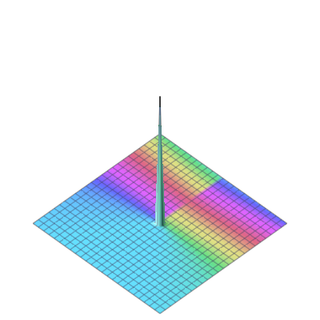The Lommel differential equation, named after Eugen von Lommel, is an inhomogeneous form of the Bessel differential equation:



Solutions are given by the Lommel functions sμ,ν(z) and Sμ,ν(z), introduced by Eugen von Lommel (1880),
![{\displaystyle s_{\mu ,\nu }(z)={\frac {\pi }{2}}\left[Y_{\nu }(z)\!\int _{0}^{z}\!\!x^{\mu }J_{\nu }(x)\,dx-J_{\nu }(z)\!\int _{0}^{z}\!\!x^{\mu }Y_{\nu }(x)\,dx\right],}](//wikimedia.org/api/rest_v1/media/math/render/svg/6c9c12b62e9547a64c69c8d9967eab12179fe5cb)
![{\displaystyle S_{\mu ,\nu }(z)=s_{\mu ,\nu }(z)+2^{\mu -1}\Gamma \left({\frac {\mu +\nu +1}{2}}\right)\Gamma \left({\frac {\mu -\nu +1}{2}}\right)\left(\sin \left[(\mu -\nu ){\frac {\pi }{2}}\right]J_{\nu }(z)-\cos \left[(\mu -\nu ){\frac {\pi }{2}}\right]Y_{\nu }(z)\right),}](//wikimedia.org/api/rest_v1/media/math/render/svg/1fbc47a009afefe3352df4095aab80828bf60c17)
where Jν(z) is a Bessel function of the first kind and Yν(z) a Bessel function of the second kind.
The s function can also be written as[1]

where pFq is a generalized hypergeometric function.




![{\displaystyle s_{\mu ,\nu }(z)={\frac {\pi }{2}}\left[Y_{\nu }(z)\!\int _{0}^{z}\!\!x^{\mu }J_{\nu }(x)\,dx-J_{\nu }(z)\!\int _{0}^{z}\!\!x^{\mu }Y_{\nu }(x)\,dx\right],}](http://wikimedia.org/api/rest_v1/media/math/render/svg/6c9c12b62e9547a64c69c8d9967eab12179fe5cb)
![{\displaystyle S_{\mu ,\nu }(z)=s_{\mu ,\nu }(z)+2^{\mu -1}\Gamma \left({\frac {\mu +\nu +1}{2}}\right)\Gamma \left({\frac {\mu -\nu +1}{2}}\right)\left(\sin \left[(\mu -\nu ){\frac {\pi }{2}}\right]J_{\nu }(z)-\cos \left[(\mu -\nu ){\frac {\pi }{2}}\right]Y_{\nu }(z)\right),}](http://wikimedia.org/api/rest_v1/media/math/render/svg/1fbc47a009afefe3352df4095aab80828bf60c17)
